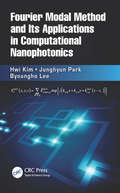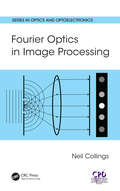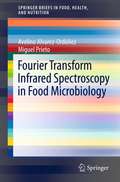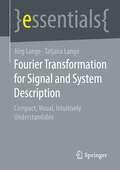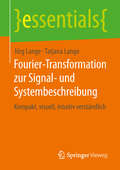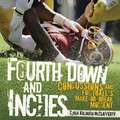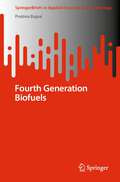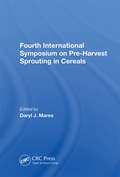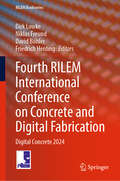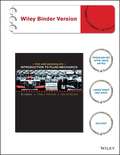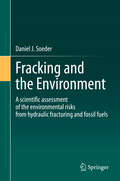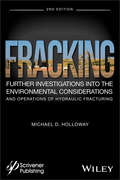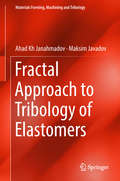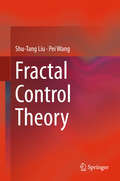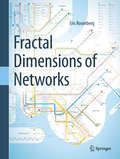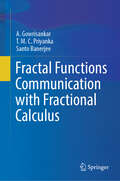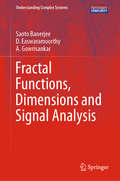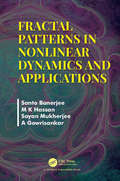- Table View
- List View
Fourier Modal Method and Its Applications in Computational Nanophotonics
by Hwi Kim Junghyun Park Byoungho LeeMost available books on computational electrodynamics are focused on FDTD, FEM, or other specific technique developed in microwave engineering. In contrast, Fourier Modal Method and Its Applications in Computational Nanophotonics is a complete guide to the principles and detailed mathematics of the up-to-date Fourier modal method of optical analysis. It takes readers through the implementation of MATLAB® codes for practical modeling of well-known and promising nanophotonic structures. The authors also address the limitations of the Fourier modal method.Features Provides a comprehensive guide to the principles, methods, and mathematics of the Fourier modal method Explores the emerging field of computational nanophotonics Presents clear, step-by-step, practical explanations on how to use the Fourier modal method for photonics and nanophotonics applications Includes the necessary MATLAB codes, enabling readers to construct their own code Using this book, graduate students and researchers can learn about nanophotonics simulations through a comprehensive treatment of the mathematics underlying the Fourier modal method and examples of practical problems solved with MATLAB codes.
Fourier Optics in Image Processing (Series in Optics and Optoelectronics)
by Neil CollingsThis much-needed text brings the treatment of optical pattern recognition up-to-date in one comprehensive resource. Optical pattern recognition, one of the first implementations of Fourier Optics, is now widely used, and this text provides an accessible introduction for readers who wish to get to grips with how holography is applied in a practical context. A wide range of devices are addressed from a user perspective and are accompanied with detailed tables enabling performance comparison, in addition to chapters exploring computer-generated holograms, optical correlator systems, and pattern matching algorithms. This book will appeal to both lecturers and research scientists in the field of electro-optic devices and systems. Features: Covers a range of new developments, including computer-generated holography and 3D image recognition Accessible without a range of prior knowledge, providing a clear exposition of technically difficult concepts Contains extensive examples throughout to reinforce learning
Fourier Transform Infrared Spectroscopy in Food Microbiology
by Avelino Alvarez-Ordóñez Miguel PrietoVibrational spectroscopy techniques, which have traditionally been used to provide non-destructive, rapid, and relevant information on microbial systematics, are useful for classification and identification. In conjunction with advanced chemometrics, infrared spectroscopy enables the biochemical signatures from microbiological structures to be extracted and analysed. In addition, a number of recent studies have shown that Fourier Transform Infrared (FT-IR) spectroscopy can help to understand the molecular basis of events, such as the adaptive tolerance responses expressed by bacteria when exposed to stress conditions in the environment, i.e. environments that cells confront in food and during food processing. The proposed Brief will discuss the published experimental techniques, data-processing algorithms, and approaches used in FT-IR spectroscopy to assist in the characterization and identification of microorganisms, to assess the mechanisms of bacterial inactivation by food processing technologies and antimicrobial compounds, to monitor the spore and membrane properties of foodborne pathogens in changing environments, to detect stress-injured microorganisms in food-related environments, to assess dynamic changes in bacterial populations, and to study bacterial tolerance responses.
Fourier Transformation for Signal and System Description: Compact, Visual, Intuitively Understandable (essentials)
by Tatjana Lange Jörg LangeThe authors explain the Fourier transform and its technical applications, especially in signal and system theory. Based on their many years of teaching experience, they aim at helping especially STEM (science, technology, engineering, and mathematics) students as well as graduated professionals to better understand the subject. The authors also point out the importance of a deeper understanding, as all modern digital technologies such as sound and image recording and storage, radio and television, mobile telephony, signal transmission for the Internet, modern control techniques for vehicles or aircrafts – are largely based on the Fourier transform. The Authors Prof. Dr.-Ing. habil. Jörg Lange held a leading position in the development area of mobile communications in a large technology company. Prof. Dr.-Ing. Tatjana Lange taught control systems engineering at Merseburg University of Applied Sciences and is still active in research in the area of classification and cluster analysis.This Springer essential is a translation of the original German 1st edition essentials, Fourier-Transformation zur Signal- und Systembeschreibung by Jörg Lange and Tatjana Lange, published by Springer Fachmedien Wiesbaden GmbH, part of Springer Nature in 2019. The translation was done with the help of artificial intelligence (machine translation by the service DeepL.com). A subsequent human revision was done primarily in terms of content, so that the book will read stylistically differently from a conventional translation. Springer Nature works continuously to further the development of tools for the production of books and on the related technologies to support the authors.
Fourier-Transformation zur Signal- und Systembeschreibung: Kompakt, Visuell, Intuitiv Verständlich
by Tatjana Lange Jörg LangeDie Autoren erläutern die Fourier-Transformation und ihre technischen Anwendungen, insbesondere in der Signal- und Systemtheorie, dank ihrer langjährigen Erfahrungen sehr anschaulich. Sie möchten insbesondere MINT-Studenten und natürlich auch im Beruf stehenden Absolventen helfen, die Materie besser zu verstehen. Die Autoren zeigen zudem die Wichtigkeit eines vertieften Verständnisses auf, da alle modernen digitalen Techniken – wie Ton- und Bildaufzeichnung und Speicherung, Rundfunk und Fernsehen, Mobilfunk, Signalübertragung für das Internet, moderne Regelungstechniken für Fahrzeuge oder Flugzeuge – weitgehend auf den Erkenntnissen der Fourier-Transformation basieren.
Fourth Down And Inches: Concussions And Football's Make-or-break Moment
by Carla Killough McclaffertyAward-winning author Carla Killough McClafferty takes readers on a bone-crunching journey from football's origins to the latest research on concussion and traumatic brain injuries in the sport.
Fourth Generation Biofuels (SpringerBriefs in Applied Sciences and Technology)
by Pratima BajpaiThis book examines the background of fourth-generation biofuel production, use of genetically modified microalgae for production of fourth-generation biofuels; cultivation and harvesting of genetically modified microalgae; residue from biofuel extraction; health and environmental concerns of fourth-generation biofuels; regulations on cultivation and processing of the genetically modified algae; carbon dioxide sequestration; water footprint and current status and key challenges. The topic caters to academic researchers and industrial experts, who work in the field of biofuels as source of alternative fuel to achieve environmental and economic sustainability.
Fourth International Symposium On Pre-harvest Sprouting In Cereals
by Daryl MaresA major constraint on the production of high-quality grain around the world, pre-harvest sprouting in cereal crops causes substantial economic losses to producers and disrupts the processing, distribution, marketing, and storage of grain products. The solution to this problem must include a better understanding of the phenomenon, the development of
Fourth RILEM International Conference on Concrete and Digital Fabrication: Digital Concrete 2024 (RILEM Bookseries #53)
by Dirk Lowke Niklas Freund David Böhler Friedrich HerdingThis book gathers peer-reviewed contributions presented at the 4th RILEM International Conference on Concrete and Digital Fabrication (Digital Concrete), held in Munich, Germany, on September 4-6, 2024. Focusing on additive and automated manufacturing technologies for the fabrication of cementitious construction materials, such as 3D concrete printing, powder bed printing, and shotcrete 3D printing, the papers highlight the latest findings in this fast-growing field, addressing topics like mixture design, admixtures, rheology and fresh-state behavior, alternative materials, microstructure, cold joints & interfaces, mechanical performance, reinforcement, structural engineering, durability and sustainability, automation and industrialization.
Fox and Mcdonald's Introduction to Fluid Mechanics (9th Edition)
by Philip J. Pritchard Rajesh Bhaskaran John C. LeylegianFox & McDonald's Introduction to Fluid Mechanics 9th Edition has been one of the most widely adopted textbooks in the field. This highly-regarded text continues to provide readers with a balanced and comprehensive approach to mastering critical concepts, incorporating a proven problem-solving methodology that helps readers develop an orderly plan to finding the right solution and relating results to expected physical behavior. The ninth edition features a wealth of example problems integrated throughout the text as well as a variety of new end of chapter problems.
Fracking and the Environment: A scientific assessment of the environmental risks from hydraulic fracturing and fossil fuels
by Daniel J. SoederThis book provides a systematic scientific approach to the understanding of hydraulic fracturing (fracking) as a hydrocarbon extraction technology and its impact on the environment. The book addresses research from the past decade to assess how fracking can affect air, water, landscapes and ecosystems, and presents the subject in the context of the history of fracking and shale gas development in the United States, describing what is known and not known about environmental impacts, and the broader implications of fossil energy use, climate change, and technology development. In 9 chapters, the author lays out how and why hydraulic fracturing was developed, what driving forces existed at the beginning of the so-called "shale revolution", how success was achieved, and when and why public acceptance of the technology changed. The intended audience is scientific people who are concerned about fracking, but perhaps do not know all that much about it. It is also intended for lay people who would be interested in understanding the technical details of the process and what effects it might or might not be having on the environment. The book is written at a level that is both understandable and technically correct. A further goal is to give some useful insights even to experienced petroleum geologists and engineers who have been doing fracking for many years.
Fracking: Further Investigations into the Environmental Considerations and Operations of Hydraulic Fracturing (Energy Sustainability Ser.)
by Michael D. HollowaySince the first edition of Fracking was published, hydraulic fracturing has continued to be hotly debated. Credited with bringing the US and other countries closer to “energy independence,” and blamed for tainted drinking water and earthquakes, hydraulic fracturing (“fracking”) continues to be one of the hottest topics and fiercely debated issues in the energy industry and in politics. Covering all of the latest advances in fracking since the first edition was published, this expanded and updated revision still contains all of the valuable original content for the engineer or layperson to understand the technology and its ramifications. Useful not only as a tool for the practicing engineer solve day-to-day problems that come with working in hydraulic fracturing, it is also a wealth of information covering the possible downsides of what many consider to be a very valuable practice. Many others consider it dangerous, and it is important to see both sides of the argument, from an apolitical, logical standpoint. While induced hydraulic fracturing utilizes many different engineering disciplines, this book explains these concepts in an easy to understand format. The primary use of this book shall be to increase the awareness of a new and emerging technology and what the various ramifications can be. The reader shall be exposed to many engineering concepts and terms. All of these ideas and practices shall be explained within the body. A science or engineering background is not required.
Fractal Apertures in Waveguides, Conducting Screens and Cavities
by Basudeb Ghosh Sachendra N. Sinha M. V. KartikeyanThis book deals with the design and analysis of fractal apertures in waveguides, conducting screens and cavities using numerical electromagnetics and field-solvers. The aim is to obtain design solutions with improved accuracy for a wide range of applications. To achieve this goal, a few diverse problems are considered. The book is organized with adequate space dedicated for the design and analysis of fractal apertures in waveguides, conducting screens and cavities, microwave/millimeter wave applications followed by detailed case-study problems to infuse better insight and understanding of the subject. Finally, summaries and suggestions are given for future work. Fractal geometries were widely used in electromagnetics, specifically for antennas and frequency selective surfaces (FSS). The self-similarity of fractal geometry gives rise to a multiband response, whereas the space-filling nature of the fractal geometries makes it an efficient element in antenna and FSS unit cell miniaturization. Until now, no efforts were made to study the behavior of these fractal geometries for aperture coupling problems. The aperture coupling problem is an important boundary value problem in electromagnetics and used in waveguide filters and power dividers, slotted ground planes, frequency selective surfaces and metamaterials. The present book is intended to initiate a study of the characteristics of fractal apertures in waveguides, conducting screens and cavities. To perform a unified analysis of these entirely dissimilar problems, the "generalized network formulation of the aperture problems" by Mautz and Harrington was extended to multiple-aperture geometry. The authors consider the problem of coupling between two arbitrary regions coupled together via multiple apertures of arbitrary shape. MATLAB codes were developed for the problems and validated with the results available in the literature as well as through simulations on ANSOFT's HFSS.
Fractal Approach to Tribology of Elastomers (Materials Forming, Machining and Tribology)
by Ahad Kh Janahmadov Maksim JavadovThis book summarizes the results of years of research on the problem of strength and fracture of polymers and elastomers. It sets out the modern approach to the strength theory from the standpoint of fractals, the kinetic and thermodynamic theories as well as the meso-mechanic destruction. The dimension reduction method is applied to model the friction processes in elastomers subjected to the complex dynamic loading. Finally, it analyses a relation between the fracture mechanism and the relation phenomena, and provides new experimental data on the sealing nodes in accordance with their specific working conditions where the effect of self-sealing is observed.
Fractal Control Theory
by Pei Wang Shu-Tang LiuThis book focuses on the control of fractal behaviors in nonlinear dynamics systems, addressing both the principles and purposes of control. For fractals in different systems, it presents revealing studies on the theory and applications of control, reflecting a spectrum of different control methods used with engineering technology. As such, it will benefit researchers, engineers, and graduate students in fields of fractals, chaos, engineering, etc.
Fractal Dimensions of Networks (Springerbriefs In Computer Science Ser.)
by Eric RosenbergCurrent interest in fractal dimensions of networks is the result of more than a century of previous research on dimensions. Fractal Dimensions of Networks ties the theory and methods for computing fractal dimensions of networks to the “classic” theory of dimensions of geometric objects.The goal of the book is to provide a unified treatment of fractal dimensions of sets and networks. Since almost all of the major concepts in fractal dimensions originated in the study of sets, the book achieves this goal by first clearly presenting, with an abundance of examples and illustrations, the theory and algorithms for sets, and then showing how the theory and algorithms have been applied to networks. Thus, the book presents the classical theory and algorithms for the box counting dimension for sets, and then presents the box counting dimension for networks. All the major fractal dimensions are studied, e.g., the correlation dimension, the information dimension, the Hausdorff dimension, the multifractal spectrum, as well as many lesser known dimensions. Algorithm descriptions are accompanied by worked examples, many applications of the methods are presented, and many exercises, ranging in difficulty from easy to research level, are included.
Fractal Functions Communication with Fractional Calculus
by Santo Banerjee A. Gowrisankar T. M. PriyankaThis book provides an in-depth examination of fractal functions, focusing on their self-similar structures and the relatively simple construction procedures that make them a subject of fascination in mathematics and engineering. By exploring fractal interpolation functions, the book sheds light on naturally occurring phenomena that exhibit irregularity and non-integer dimensions, offering a fresh perspective on these complex mathematical constructs. The chapters cover a range of topics, including the foundational principles of fractal geometry, the construction of fractal functions through iterated function systems, and the critical role of scaling parameters. Readers will find expert analyses of affine and non-affine fractal functions, as well as discussions on the application of fractional calculus methods such as the Riemann-Liouville and Caputo derivatives. The book also explores the practical applications of fractal interpolation in areas like epidemiology and climate dynamics, demonstrating the relevance of these mathematical concepts to real-world problems. This volume is an essential resource for researchers and scholars in mathematics, engineering, and related fields. It offers a comprehensive overview of the current research on fractal functions and fractional calculus, providing readers with the tools to understand and apply these concepts in their work. Whether you are an academic seeking to deepen your knowledge or a practitioner looking to apply fractal functions to practical challenges, this book is a valuable addition to your library. It invites you to engage with the latest research and explore the potential of fractal functions in addressing complex scientific and engineering problems.
Fractal Functions, Dimensions and Signal Analysis (Understanding Complex Systems)
by Santo Banerjee D. Easwaramoorthy A. GowrisankarThis book introduces the fractal interpolation functions (FIFs) in approximation theory to the readers and the concerned researchers in advanced level. FIFs can be used to precisely reconstruct the naturally occurring functions when compared with the classical interpolants. The book focuses on the construction of fractals in metric space through various iterated function systems. It begins by providing the Mathematical background behind the fractal interpolation functions with its graphical representations and then introduces the fractional integral and fractional derivative on fractal functions in various scenarios. Further, the existence of the fractal interpolation function with the countable iterated function system is demonstrated by taking suitable monotone and bounded sequences. It also covers the dimension of fractal functions and investigates the relationship between the fractal dimension and the fractional order of fractal interpolation functions. Moreover, this book explores the idea of fractal interpolation in the reconstruction scheme of illustrative waveforms and discusses the problems of identification of the characterizing parameters. In the application section, this research compendium addresses the signal processing and its Mathematical methodologies. A wavelet-based denoising method for the recovery of electroencephalogram (EEG) signals contaminated by nonstationary noises is presented, and the author investigates the recognition of healthy, epileptic EEG and cardiac ECG signals using multifractal measures. This book is intended for professionals in the field of Mathematics, Physics and Computer Science, helping them broaden their understanding of fractal functions and dimensions, while also providing the illustrative experimental applications for researchers in biomedicine and neuroscience.
Fractal Patterns in Nonlinear Dynamics and Applications: Patterns in Nonlinear Dynamics and Applications
by Sayan Mukherjee Santo Banerjee M K Hassan A GowrisankarMost books on fractals focus on deterministic fractals as the impact of incorporating randomness and time is almost absent. Further, most review fractals without explaining what scaling and self-similarity means. This book introduces the idea of scaling, self-similarity, scale-invariance and their role in the dimensional analysis. For the first time, fractals emphasizing mostly on stochastic fractal, and multifractals which evolves with time instead of scale-free self-similarity, are discussed. Moreover, it looks at power laws and dynamic scaling laws in some detail and provides an overview of modern statistical tools for calculating fractal dimension and multifractal spectrum.
Fractal Patterns with MATLAB (SpringerBriefs in Complexity)
by Santo Banerjee A. Gowrisankar Komandla Mahipal ReddyThis book presents the iterative beauty of fractals and fractal functions graphically with the aid of MATLAB programming. The fractal images generated using the MATLAB codes provide visual delight and highly encourage the fractal lovers for creative thinking. The book compiles five cutting-edge research chapters, each with state-of-the art fractal illustrations. It starts with the fundamental theory for the construction of fractal sets via the deterministic iteration algorithm. Incorporating the theoretical base, fractal illustrations of elementary fractal sets are provided with the explicit MATLAB code. The book gives examples of MATLAB codes to present the fractal surfaces. This book is contributed to all the research beginners as well as the professionals on the field of fractal analysis. As it covers basic fractals like Sierpinski triangle to advanced fractal functions with explicit MATLAB code, the presented fractal illustrations hopefully benefit even the non-field readers. The book is a useful course to all the research beginners on the fractal and fractal-related fields.
Fractal Symmetry of Protein Exterior
by Anirban BanerjiThe essential question that fractal dimensions attempt to answer is about the scales in Nature. For a system as non-idealistic and complex as a protein, studying scale-invariance becomes particularly important. Fractal Symmetry of Protein Exterior investigates the diverse facets of the various scales at which we describe protein biophysical and biochemical phenomena. Although these ideas are entirely mathematical, mathematical expositions have been avoided, unless the use of some expressions becomes absolutely obligatory. A first chapter introduce into fractal dimensions, protein exteriors and to methods to study the roughness of surfaces. The main topics covered in the following chapters include: protein-protein interaction interfaces; protein surface-roughness and local shape as well as adhesion on protein and other rough biomolecular surfaces.
Fractal Time: The Secret Of 2012 And A New World Age
by Gregg BradenIn his latest book, former senior computer systems designer and bestselling author Gregg Braden merges these ancient and modern world views into a powerful new model of time. Marrying the modern laws of fractal patterns to the ancient concept of cycles, he demonstrates how everything from the war and peace between nations to our most joyous relationships and personal crises are the returning patterns of our past. As each pattern returns, it carries the same conditions of previous cycles-fractal patterns that can be known, measured and predicted! What makes this model so important today is that the returning cycles also carry a window of opportunity-a choice point-that allows us to choose a new outcome for the cycle. Braden suggests that if we can see time from this perspective, the patterns will show us what's in store for the future, and perhaps how to avoid the mistakes of our past. After presenting the case histories that confirm the accuracy of fractal time calculations, the author crosses the traditional boundaries of science and spirituality to answer the question that must be asked: What does fractal time tell us about 2012, and beyond? Because the cycles repeat, the seed for 2012 has already happened and the pattern already exists! In a narrative format of easy-to-read science and true-life accounts, Fractal Time shows us what we can expect as we close the Great World Age described by the Mayan Calendar, and the secret to our moment in history.
Fractal Time: Why a Watched Kettle Never Boils (Studies of Nonlinear Phenomena in Life Science, Volume 14)
by Susie VrobelThis book provides an interdisciplinary introduction to the notion of fractal time, starting from scratch with a philosophical and perceptual puzzle.
Fractal Worlds: Grown, Built, and Imagined
by Michael Frame Amelia UrryFractal geometry is a uniquely fascinating area of mathematics, exhibited in a range of shapes that exist in the natural world, from a simple broccoli floret to a majestic mountain range. In this essential primer, mathematician Michael Frame—a close collaborator with Benoit Mandelbrot, the founder of fractal geometry—and poet Amelia Urry explore the amazing world of fractals as they appear in nature, art, medicine, and technology. Frame and Urry offer new insights into such familiar topics as measuring fractal complexity by dimension and the life and work of Mandelbrot. In addition, they delve into less-known areas: fractals with memory, the Mandelbrot set in four dimensions, fractals in literature, and more. An inviting introduction to an enthralling subject, this comprehensive volume is ideal for learning and teaching.
Fractals and Multifractals in Ecology and Aquatic Science
by Laurent SeurontEcologists sometimes have a less-than-rigorous background in quantitative methods, yet research within this broad field is becoming increasingly mathematical. Written in a step-by-step fashion, Fractals and Multifractals in Ecology and Aquatic Science provides scientists with a basic understanding of fractals and multifractals and the techniques fo
